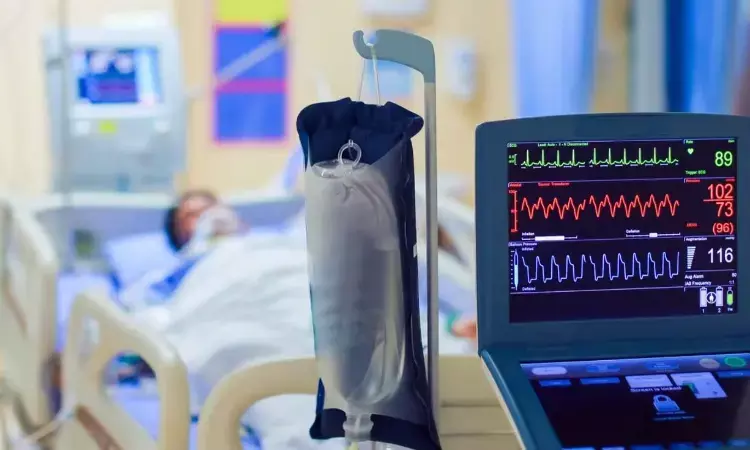- Home
- Medical news & Guidelines
- Anesthesiology
- Cardiology and CTVS
- Critical Care
- Dentistry
- Dermatology
- Diabetes and Endocrinology
- ENT
- Gastroenterology
- Medicine
- Nephrology
- Neurology
- Obstretics-Gynaecology
- Oncology
- Ophthalmology
- Orthopaedics
- Pediatrics-Neonatology
- Psychiatry
- Pulmonology
- Radiology
- Surgery
- Urology
- Laboratory Medicine
- Diet
- Nursing
- Paramedical
- Physiotherapy
- Health news
- Fact Check
- Bone Health Fact Check
- Brain Health Fact Check
- Cancer Related Fact Check
- Child Care Fact Check
- Dental and oral health fact check
- Diabetes and metabolic health fact check
- Diet and Nutrition Fact Check
- Eye and ENT Care Fact Check
- Fitness fact check
- Gut health fact check
- Heart health fact check
- Kidney health fact check
- Medical education fact check
- Men's health fact check
- Respiratory fact check
- Skin and hair care fact check
- Vaccine and Immunization fact check
- Women's health fact check
- AYUSH
- State News
- Andaman and Nicobar Islands
- Andhra Pradesh
- Arunachal Pradesh
- Assam
- Bihar
- Chandigarh
- Chattisgarh
- Dadra and Nagar Haveli
- Daman and Diu
- Delhi
- Goa
- Gujarat
- Haryana
- Himachal Pradesh
- Jammu & Kashmir
- Jharkhand
- Karnataka
- Kerala
- Ladakh
- Lakshadweep
- Madhya Pradesh
- Maharashtra
- Manipur
- Meghalaya
- Mizoram
- Nagaland
- Odisha
- Puducherry
- Punjab
- Rajasthan
- Sikkim
- Tamil Nadu
- Telangana
- Tripura
- Uttar Pradesh
- Uttrakhand
- West Bengal
- Medical Education
- Industry
Enteral feeding significantly associated with constipation in Critically sick patients

In a new study conducted by Aaron Heffernan and team it was shown that most outcome indicators pertinent to the management of critically sick patients were not found to vary clinically. The findings of this study were published in BMC Critical Care.
It is normal practice to address the dietary needs of critically sick patients via the enteral route. However, there is a dearth of information to instruct professionals on how to provide the required amount in the most effective way. Although bolus or intermittent methods of delivery may have various benefits, including minimizing interruptions, continuous enteral feeding is still widely employed. This meta-analysis compares enteral nutrition delivery methods that are continuous vs intermittent or bolus.
Studies found in the EMBASE, PubMed, Cochrane Library, and Web of Science databases were subjected to a systematic review and meta-analysis. Studies were included if they evaluated enteral nutrition administered continuously vs intermittently or through bolus in adult patients hospitalized to the critical care unit. Using the PEDro and Newcastle-Ottawa rating systems, study quality was evaluated. The random-effects meta-analysis on the endpoints of mortality, diarrhea, constipation, increased stomach residuals, pneumonia, and bacterial colonization was conducted using Review Manager.
The key findings of this study were:
1. A total of 5546 articles were found, and 133 of those were selected for full-text analysis.
2. In the end, fourteen were taken into consideration.
3. Patients receiving continuous enteral feeding had a higher incidence of constipation (relative risk 2.24, 95% confidence range 1.01-4.97, p = 0.05).
4. Other outcome measures revealed no differences. No discernible bias was found.
In conclusion, the two EN techniques (intermittent feeding and continuous feeding) were compared in this review for critically sick patients. Unfortunately, there is a lack of information that prevents physicians in intensive care units from knowing which feeding strategy is appropriate for their patients. To determine whether feeding technique fulfills nutritional objectives and recovery, metabolic function, and has the fewest short-term problems, more study is required.
Reference:
Heffernan, A. J., Talekar, C., Henain, M., Purcell, L., Palmer, M., & White, H. (2022). Comparison of continuous versus intermittent enteral feeding in critically ill patients: a systematic review and meta-analysis. In Critical Care (Vol. 26, Issue 1). Springer Science and Business Media LLC. https://doi.org/10.1186/s13054-022-04140-8
Neuroscience Masters graduate
Jacinthlyn Sylvia, a Neuroscience Master's graduate from Chennai has worked extensively in deciphering the neurobiology of cognition and motor control in aging. She also has spread-out exposure to Neurosurgery from her Bachelor’s. She is currently involved in active Neuro-Oncology research. She is an upcoming neuroscientist with a fiery passion for writing. Her news cover at Medical Dialogues feature recent discoveries and updates from the healthcare and biomedical research fields. She can be reached at editorial@medicaldialogues.in
Dr Kamal Kant Kohli-MBBS, DTCD- a chest specialist with more than 30 years of practice and a flair for writing clinical articles, Dr Kamal Kant Kohli joined Medical Dialogues as a Chief Editor of Medical News. Besides writing articles, as an editor, he proofreads and verifies all the medical content published on Medical Dialogues including those coming from journals, studies,medical conferences,guidelines etc. Email: drkohli@medicaldialogues.in. Contact no. 011-43720751


